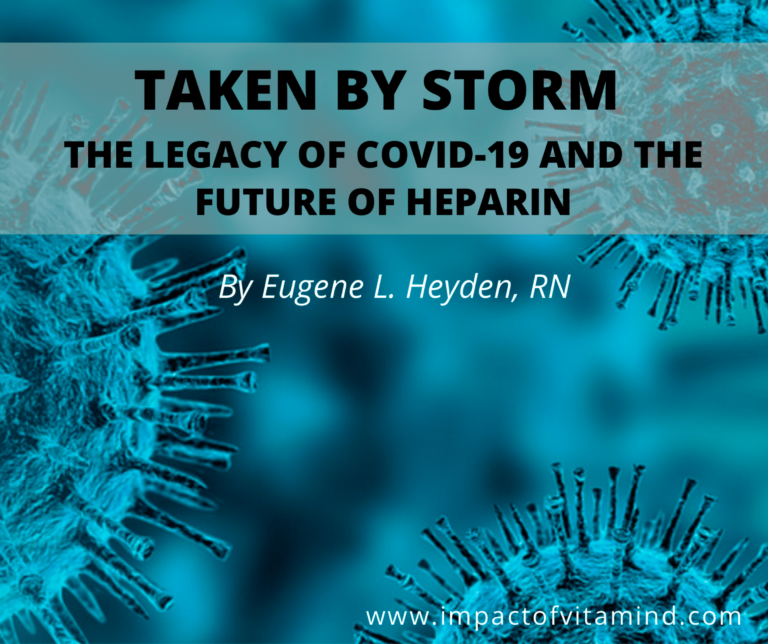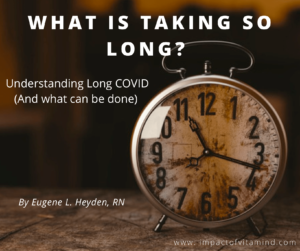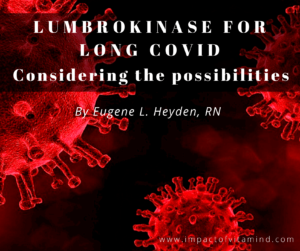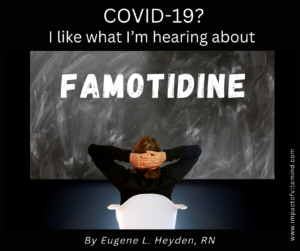Taken by Storm: The Legacy of COVID-19 and the Future of Heparin

Topic: Legacy of COVID-19; Future of Heparin
Last update: 01-10-23
By Eugene L. Heyden, RN
Severe SARS-CoV-2 infection mostly presents with coagulation abnormalities, pulmonary microvascular thrombosis, and severe inflammatory response. ~Fard et al., 2021, emphasis added)
The cause for which patients with severe COVID-19 die is not related to the damage caused by the replication of the SARS-CoV-2 virus but rather it seems to be linked to the so-called cytokine storm. ~Lete, 2021
Although the virus known as SARS-CoV-2 is new to the human experience, the immune response to the virus is not. The invading virus awaits an immune system capable of mounting a formidable defense. And most often, the virus is vanquished with little notice and with little fanfare. However, for many, the war effort is a little messy, yet a successful outcome follows, and life goes on. On the other hand, should the infection be sufficiently advanced and viral replication accelerates unabated, a life is threatened, and it is all-out war. Here, we will discuss the nature of this war. We will also discuss a most promising therapeutic, namely heparin.
Those in the healthcare field are already quite familiar with the anticoagulant known as heparin. It is one of our most essential drugs, particularly in hospital medicine. But did you know, heparin is an anti-inflammatory drug? And did you know heparin can bind and inactivate the virus that causes COVID-19, preventing its entry into the cell? And if that wasn’t enough, heparin has a few other tricks up its sleeve that make it particularly useful in the battle against COVID-19. So, without further ado, let’s begin our little journey together. Prepare to be amazed!
Taken by Storm: The Legacy of COVID-19 and the Future of Heparin
Abstract: Despite exposure mitigation and vaccination, the SARS-CoV-2 infection continues to be an enormous threat to the vulnerable and an ongoing challenge to the medical community. Investigations into how the virus infects, how it spreads, and how the immune system responds have identified therapeutic approaches that can halt the cascade of events that lead to the loss of life. In this regard, heparin has emerged as a particularly effective therapeutic, capable of addressing several key pathological events that occur during the course of the disease. Notably, heparin can limit the severity of an immunological defense mechanism known as immunothrombosis. In immunothrombosis, platelet-driven clot formation serves to isolate, immobilize, and contain the invading pathogen, impeding its spread from the alveolar microcirculation into the general circulation. Immunothrombosis is the platelets’ attempt to avert a disaster and save a life. Aside from clot formation, the platelet is programmed to respond to the viral threat in a variety of ways. The platelet can engulf and internalize the virus with lethal intent. The platelet can release antiviral molecules that disable and destroy. And the platelet can act to recruit other immune cells and compel them to participate in a coordinated defense against the virus, shaping their functions and directing their actions. Given these behaviors, the platelet should be regarded as an immune cell in its own right and recognized as the immune cell relied upon to orchestrate the final defense against SARS-CoV-2 invasion. However, this defense is not without collateral damage, even death, and should be therapeutically addressed. Let’s see how it all plays out in this narrative review.
To continue reading, click here: Taken by Storm PDF
Topic: Legacy of COVID-19; Future of Heparin
References
Fard MB, Fard SB, Ramazi S, Atashi A, Eslamifar Z. Thrombosis in COVID-19 infection: Role of platelet activation-mediated immunity. Thrombosis Journal. 2021 Dec;19(1):1-1. https://link.springer.com/article/10.1186/s12959-021-00311-9
Lete I. Combined hormonal contraception and COVID-19. The European Journal of Contraception & Reproductive Health Care. 2021 Mar 4;26(2):128-31. https://www.tandfonline.com/doi/abs/10.1080/13625187.2020.1867845
Disclaimer: This article is offered solely for informational purposes. The information contained therein should be evaluated for accuracy and validity in the context of opposing data, new information, and the views and recommendations of a qualified health care professional, and not to be substituted for professional judgment and guidance or to provide a reason to neglect or delay appropriate medical care for self or for others. It is the reader and reader only who bears the responsibility for any actions that could be construed as being a response to the information presented. The statements and opinions expressed by the author or authors of the information provided on this website have not been reviewed or approved by the FDA or by any other authoritative body, nor is the author endorsing any product or specific therapy mentioned. This article and the opinions therein are offered to the reader to broaden his or her understanding of the issues discussed and to help identify options that may be suitable for the individual to pursue, on behalf of self or others, under approval and direction of a qualified physician or medical team member. All questions of a medical nature which arise from reading this article should be directed at qualified health care professional.
Related posts (Click image to open)
Copyright © 2022–2023 Eugene L. Heyden, RN
All Rights Reserved






